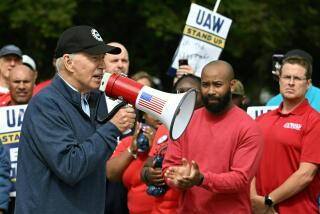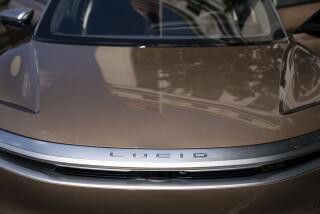Autoworker unions: villains or victims?
Today’s topic: Are labor unions a victim or villain in the decline of the Detroit Big Three? Shikha Dalmia and David Madland discuss the state and future of American labor unions.
A New Deal-era model is sinking the Big Three
Point: Shikha Dalmia
A simple moral vocabulary is rarely adequate to describe situations arising from decades of bad laws, and so it is with the problems faced by General Motors, Ford and Chrysler, also known as the Detroit Big Three. Unions are not villains, but they are exceedingly powerful. And they are powerful because of a deal that big labor, big government and big business struck during the New Deal when the Wagner Act was passed in 1935.
Under Wagner, once a union was certified by the new National Labor Relations Board, it earned the right to collect mandatory dues from workers and represent them at the bargaining table. Employees couldn’t opt out of the union -- and employers couldn’t refuse to deal with it.
But as Sheldon Richman, the editor of Freeman magazine, has pointed out, most big companies didn’t mind. That’s because the Wagner Act also banned wildcat strikes and other actions, tempering an unruly labor movement. What’s more, companies preferred dealing with one union with a unified set of demands instead of many unions with conflicting demands. In short, big government got new powers to regulate workplace contracts, big labor got new powers over workers and employers, and big business got peace.
This cozy little arrangement worked quite well as long as the U.S. auto industry controlled more than 75% of the U.S. car market. Unions kept bidding up wages and benefits and the (former) Big Three kept passing them on to their customers. These perks included:
- The jobs bank program that, until last week, indefinitely paid laid-off workers nearly full wages to do nothing.
- Lifetime healthcare benefits for workers and their spouses.
- Rigid workplace rules and featherbedding practices designed to stymie productivity and protect jobs.
- So-called 30-and-out contracts, which allowed employees represented by the United Auto Workers to retire with full benefits after 30 years on the job, regardless of age.
But once Japanese imports arrived on the scene, this deal became unsustainable. Detroit’s U.S. market share is now less than 45%. One big reason (apart from sclerotic management) is that every car rolling out of Detroit contains up to $1,500 more in legacy and other labor costs compared with those built elsewhere in the U.S. by foreign makers.
The Big Three pretend that had it not been for the current financial meltdown, they would have been just fine. That is wishful thinking. Indeed, even after the concessions made by the UAW in 2007 (partially capping retiree healthcare and other legacy costs) go into effect next year, the Big Three workers will still earn $10 more per hour in wages and benefits than Toyota workers. That is progress, to be sure, given this gap currently stands at $25 per hour. But the market rewards value, not progress, especially because Toyota is not the only company that Detroit has to worry about. Some of the smaller foreign carmakers are even leaner, outsourcing much of their parts supply, a practice that the UAW continues to limit relatively tightly.
It is not surprising that the UAW used its massive New Deal powers to extract princely benefits when the Big Three faced no imminent threat to their existence. What’s baffling is that the union is refusing to throw them a lifeline now when they are near death’s door. UAW President Ron Gettelfinger, for instance, has resisted even the tinniest of gestures, such as accelerating the timetable for implementing the 2007 labor contract.
But there might be a limit to how long taxpayers will keep bailing out Detroit. Should the U.S. automakers go under, unions will be victims -- but of their own myopia and intransigence.
Shikha Dalmia is a senior analyst at the Reason Foundation.
GM, Ford CEOs make millions as their companies lose billions
Counterpoint: David Madland
I credit you, Shikha, for acknowledging that the decline of U.S. automakers is linked to a number of factors. But you get the story wrong by assigning far too much blame to the role of workers and their unions.
Labor costs are less than 10% of the cost of a car; the other 90% goes toward research and development of new product lines, parts, advertising, marketing and management overhead. Surely this 90% is more likely to be a source of poor competitiveness, especially because, according to data from the latest Harbour Report, an annual study of manufacturing efficiency, nine out of the 10 most efficient auto assembly plants in North America are union plants, represented by either the UAW or the Canadian Auto Workers. In addition, one of Toyota’s successful assembly plants in California is unionized.
Although the average hourly wage of a UAW worker is a few dollars more than a non-unionized auto worker, any labor cost advantage the Japanese automakers have is due almost entirely to the fact that these companies have far fewer retirees. Honda, Nissan and Toyota have been operating in the United States for close to 30 years and thus haven’t had many workers reach retirement age. Ford and General Motors, however, have been around for nearly a century; Chrysler has existed since 1925. Of course the U.S. auto companies face higher legacy costs.
According to a 2008 article in Business Week, the cost advantage enjoyed by foreign-nameplate automakers in the U.S. may disappear by 2011 because of changing demographics and the numerous concessions made by the UAW (an indication that workers have been reasonable partners rather than intransigent, as you claim, Shikha). The UAW’s concessions include slashing wages for new employees, taking over retiree healthcare obligations and eliminating job security programs, evidence that serves to discredit your characterization of UAW chief Gettelfinger as being resistant to “even the tinniest of gestures.”
Executive compensation is perhaps a more meaningful barometer of demonstrated priorities and cost structures. According to the Securities and Exchange Commission, in 2007, Ford’s chief executive, Alan Mulally, was compensated $21.67 million, when in the same year Ford recorded losses of $2.72 billion. GM’s chief, Rick Wagoner, earned $15.7 million in compensation in 2007, while the company posted losses of $38.7 billion. In contrast, Toyota’s top executive, Hiroshi Okuda, earned only $903,000. Thus, the prevailing management philosophy at the Big Three (and too many other U.S. companies), which divorces compensation from business performance, is a more likely culprit of the industry’s troubles than the UAW.
But the bigger problem with your argument, Shikha, is that you attempt to discredit the idea of workers joining together in unions to better themselves. You dismiss the fact that unionized autoworkers played a key role in building the American middle class and helped raise wages, benefits and working conditions for all workers.
More fundamentally, you seem to think that there is something unholy about workers realizing some of the profits they help create. You call it a “cozy little arrangement,” but workers earned the right to join together and collectively bargain in 1935 by literally getting beaten over the head by CEOs who felt they should be able to dictate poor pay and lousy working conditions as a take-it-or-leave-it proposition.
David Madland is director of the American Worker Project for the Center for American Progress Action Fund.
More to Read
A cure for the common opinion
Get thought-provoking perspectives with our weekly newsletter.
You may occasionally receive promotional content from the Los Angeles Times.






